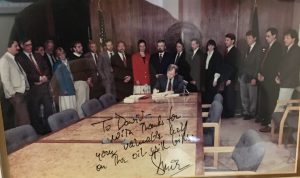Council report documents the history and intent behind Alaska’s standard for spill response planning
Alaska, and Prince William Sound in particular, is known for its world-class oil spill prevention and response system. But it wasn’t always that way. In March of 1989, when the Exxon Valdez ran aground and spilled an estimated 11 million gallons of crude oil, responders were ill-prepared.
“Nothing arrived. There was nothing there.”
– Marilyn Heiman
Staff member for the Alaska House Resources Committee,
on the experience of waiting days for equipment to arrive.

Many changes have been made since then. A recent report, funded by the Council, tells the story of how Alaskans came together in the disaster’s aftermath to change the laws governing oil spill response in Alaska.
Researchers Tim Robertson and Elise DeCola of Nuka Research interviewed many of those directly involved in creating these standards and compiled their stories. Robertson directed oil spill response operations in Seldovia after the Exxon Valdez spill and was an early member of the Council’s Board of Directors.
Early contingency plans didn’t equal an effective response
The report chronicles problems related to the early spill contingency plans that contributed to the Exxon Valdez disaster. The plan that was in place in 1989 listed equipment needed for a response. However, some of that equipment was buried under 10 feet of snow, a response barge was undergoing maintenance, and there were not enough trained personnel on hand to respond to the spill. Three days after the spill, a winter storm spread the oil farther.
“The problem wasn’t a lack of regulations; it was that the regulations had not compelled an adequate oil spill response system,” according to the report.
“How did we know we’d built the right-sized system? The Cordova fishing fleet wanted ten times as much equipment, and industry wanted to cut it in half.”
– Michael Williams
Former BP attorney
An emergency order from Alaska’s governor planted the seed that grew into today’s robust system
Two weeks after the spill, Alaska Governor Steve Cowper issued an emergency order that noted the failures of the previous plan. The order also defined what he expected to be put in place: a robust new system that could handle an Exxon Valdez-sized spill. The governor gave Alyeska 38 days to set it up and threatened to shut down the terminal if they did not comply.
A team of oil industry experts, attorneys, state employees, and spill response specialists came together with their wide range of experience in oil spill response to solve this challenge.
The report chronicles the challenges and breakthroughs the group encountered while developing the revolutionary new system. They sought advice from the oil shipping industries in Norway and Scotland to develop the system of escort tugs, oil storage barges, boom, skimmers, and trained personnel. This interim system was designed to meet the governor’s order and became the genesis of Alyeska’s current Ship Escort/Response Vessel System.
New regulations based on real events
With the realization that the response to the spill had been inadequate, new regulations were soon underway. Lawmakers based their new rules on this interim plan and the lessons from the Exxon Valdez spill.
House Bill 567, as it was known, contained very specific terms. The authors of the bill wanted a “self-executing” law for the most part. This means the law was written in a way that allowed little room for interpretation.
Many of the specifics required compromise, including the amount of oil the industry had to plan to clean up and how much time they had to be able to pick up that oil.
“At the end of the day, we needed a suite of bills that nobody loved but everybody could live with.”
– Drue Pearce
Former Senator
The resulting requirement was that industry must be able to contain, control, and clean up 300,000 barrels, or 12.6 million gallons, slightly more than the amount spilled by the Exxon Valdez, in the first 72 hours after a spill. This included not just having the equipment, but making sure it was ready to go and that people were trained on how to use the equipment.
Download the full report:
More stories are documented in the Council’s report, which describes in detail requirements such as personnel training and equipment maintenance, among others:
Alaska’s Oil Spill Response Planning Standard – History And Legislative Intent
Alaska’s Oil Spill Response Planning Standard (Graphic Version)